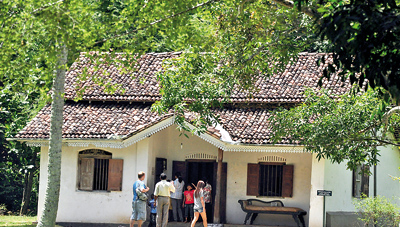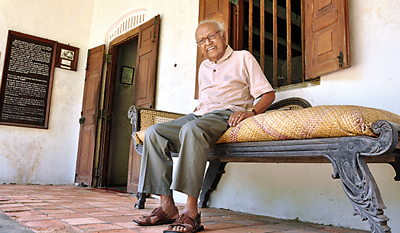Explore the memory of the ‘Sage of Koggala’
Vasantha Kumara (V.K) Wickramasinghe lingers at the doorway. This small house in Koggala has been the scene of many a happy memory for him…he reminisces fondly about cricket on the lawn with his brothers and evenings spent soaking in the stillness of village life. There’s more to this abode than happy childhood memories for him and his family though-this is also the birthplace and much loved home of their father, Martin Wickramasinghe.

The writer’s ancestral home: Still well preserved. Pix by Amila Gamage
Today the nine-acre property of the great author’s ancestral home in Koggala has been converted into the Martin Wickramasinghe Museum of Folk Culture, an enduring legacy of the wordsmith’s love affair with his hometown and the Sri Lankan way of life.
The museum houses an extensive collection of artefacts resonant of Sri Lankan rural life and more importantly, life in Koggala. The ancient horse carriages, weaving machines and scrolls among the many items in the museum provide an insight into the folk culture of a land with 2500 years’ of history and the technology used by our ancestors to get about their daily lives.
These artefacts have been acquired over a period of almost four decades by the author’s family since the establishment of the Martin Wickramasinghe Trust in 1976. The Trust was set up following the author’s death aged 86 in the same year and was a cumulative effort by his sons to carry on their father’s legacy in the arts. Martin Wickramasinghe was one of the greatest authors the country has produced having penned almost a hundred books during his lifetime. His works have been translated into over 10 languages and been read by almost every Sri Lankan.
Wickramasinghe was born in 1890 in the Southern coastal town of Koggala, bordered by beautiful reef-studded beaches on one side and innumerable streams and fields on the other. He would later immortalise these sights in his works- most memorably the island of Madol Duwa in the book of the same name. He penned his first book aged a precocious 11 (Balopadeshaya, Advice to Children) and that was just the beginning of a career that would see him author such great works as Gamperaliya, Kaligyugaya and Bava Tharanaya. In 1916 he joined the Sinhala daily Dinamina – he would later on become editor of the paper. Following his marriage to Prema De Silva in 1925 and the birth of his children Wickramasinghe took up permanent residence in Mount Lavinia. Yet he would never forget his hometown and returned frequently to the quiet confines of his ancestral home till his death in 1976.

V.K. Wickramasinghe: Happy memories of a childhood abode
For Dayapala Jayanetti his memories of the author are as fresh in his mind as they were over 40 years ago. Mr. Jayanetti was Wickramasinghe’s constant companion during his last few years and has an almost encyclopaedic knowledge of the author’s work. Their friendship had an interesting beginning; a former teacher and journalist, Mr. Jayanetti’s first encounter with the author was when he was asked to write a review for a collection of short stories Wickramasinghe had penned. He recalls visiting the author at his home down Kirimandala Mawatha in 1969. “I was invited in by Mrs. Wickramasinghe, and was then directed to a room,” he says. “Inside I saw Mr. Wickramasinghe teaching two small children how to write short stories. He was quite old then and his eyesight wasn’t too good so he didn’t see me and went on talking to them for about 20 minutes.”
Mr. Jayanetti smiles as he recounts the writer’s hospitality; upon seeing him he had immediately called for his wife to bring him something to drink. “He asked me what I thought of his latest work and I said I was a fan.” Somehow, the friendship that was forged that afternoon would last almost a decade. Mr. Jayanetti worked as proof reader for the author and also wrote the glossary for his controversial ‘Bavatharanaya’. “My goodness, the reaction people had to that book,” he muses. Bavatharanaya was the author’s account of Prince Siddhartha-the life of Lord Buddha before He attained enlightenment. “I remember monks writing to him accusing him of blasphemy-all because there’s a line where he says that the Prince kissed his wife’s face.” He remembers the author shrugging off this unfounded criticism with a quick witted reply. In many ways it was the trademark humour of a man who never took himself too seriously, says Mr. Jayanetti.
Though his eyesight was failing him Wickramasinghe’s memory was still a well-oiled machine. “I used to help him when he was writing by going up and down bringing him whatever he needed from his library,” remembers Mr. Jayanetti. “When he wanted material for his writing from his other works he would tell me exactly what shelf to choose from and which book to pick and page number to turn to, and then proceed to tell me what line!” As with any respectable writer, Wickramasinghe’s library was a treasure trove of classics. In his book “Mathakin dhutu atheethayak” Dr. Ranga Wickramasinghe describes his father’s library and the love and respect he showed towards his books.
These books provided the foundation for his extensive and varied works. Martin Wickramasinghe’s writing has the ability to capture any frame of mind. While his work was influenced primarily by his hometown Koggala his varied interest in science, religion, philosophy and anthropology reached out to readers of different tastes and age groups.
Two young residents of Koggala-Shanika (16) and Tharushi (15)- both admitted to being avid readers of his books. “We value them because they are realistic. His books can be understood by anyone,” they said. Even today, more than 30 years after his death, children grow up reading of the adventures of “Upali” and “Jinna” on the island of “Madol Duwa” while other novels such as “Gamperaliya” examine the still prevalent issues of family politics in society.

Museum exhibits: Masks and puppets
The Martin Wickramasinghe museum is the ideal place to explore the memory of the “Sage of Koggala”, as he was lovingly referred to. The folk museum comprises his ancestral home, his resting place, the extensive halls of its archives, and the ‘Hall of Life’, a room full of his personal effects and work.
The exhibits ranging from wooden fish traps to antique buggies and authentic costumes capture a Sri Lanka of yesteryear. The museum was a “collective effort” smiles Mr. V.K. Wickramasinghe who along with his siblings continue to keep their father’s memory alive in the hearts of his readers.
There’s an interesting story about the Wickramasinghe home-in 1941 the colonial government took over the village of Koggala for a military base, and every single house was to be razed to the ground. Somehow, a woman officer took a fancy to the house and asked that she be allowed to use it. And so the ancestral home survived and was handed over to Wickramasinghe by the Government two decades later. “While my father grew accustomed to Colombo his heart never left Koggala,” says V.K. Wickramasinghe. “He always returned to Koggala given half the chance.”
comments powered by Disqus

